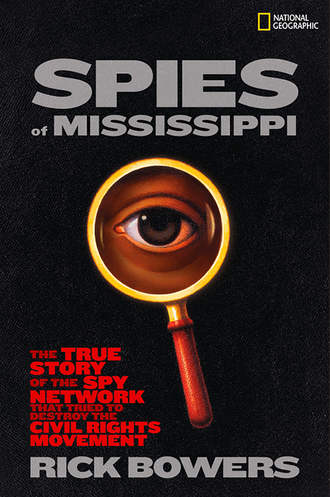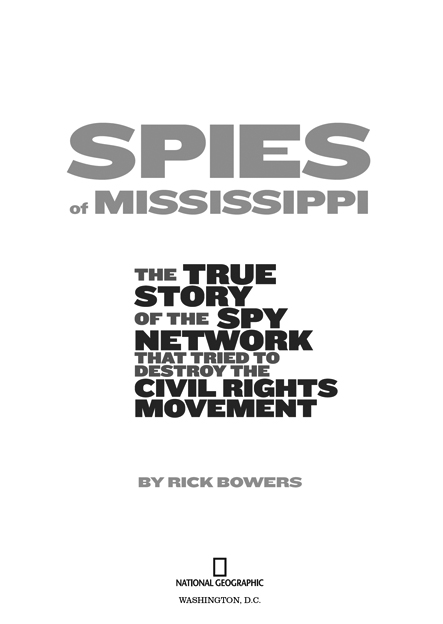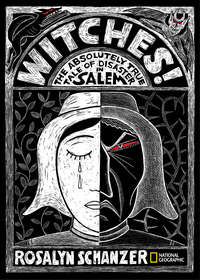
Полная версия
Spies of Mississippi: The True Story of the Spy Network that Tried to Destroy the Civil Rights Movement


Copyright © 2010 Richard J. Bowers.
All rights reserved. Reproduction of the whole or any part of the contents without written permission from the publisher is prohibited.

The National Geographic Society is one of the world’s largest nonprofit scientific and educational organizations. Founded in 1888 to “increase and diffuse geographic knowledge,” the Society works to inspire people to care about the planet. It reaches more than 325 million people worldwide each month through its official journal, National Geographic, and other magazines; National Geographic Channel; television documentaries; music; radio; films; books; DVDs; maps; exhibitions; school publishing programs; interactive media; and merchandise. National Geographic has funded more than 9,000 scientific research, conservation and exploration projects and supports an education program combating geographic illiteracy. For more information, visit nationalgeographic.com.
For more information, please call 1-800-NGS LINE (647-5463) or write to the following address:
National Geographic Society
1145 17th Street N.W.
Washington, D.C. 20036-4688 U.S.A.
Visit us online at www.nationalgeographic.com/books
For librarians and teachers: www.ngchildrensbooks.org
More for kids from National Geographic: kids.nationalgeographic.com
For information about special discounts for bulk purchases, please contact National Geographic Books Special Sales: ngspecsales@ngs.org
For rights or permissions inquiries, please contact National Geographic Books Subsidiary Rights: ngbookrights@ngs.org
Library of Congress Cataloging-in-Publication Data
Bowers, Rick, 1952-
The spies of Mississippi : the true story of the spy network that tried to destroy the civil rights movement / by Rick Bowers. – 1st ed.
p. cm.
Includes bibliographical references.
ISBN 978-1-4263-0595-5 (hardcover : alk. paper) – ISBN 978-1-4263-0596-2 (library binding : alk. paper)
eBook ISBN: 978-1-4263-0736-2
1. Mississippi State Sovereignty Commission–History. 2. African Americans–Civil rights–Mississippi–History–20th century. 3. African Americans–Segregation–Mississippi–History–20th century. 4. States’ rights (American politics)–History–20th century. 5. Mississippi–Politics and government–1951-6. Mississippi–Race relations. 7. Civil rights movements–Mississippi–History–20th century. I. Title.
E185.93.M6B69 2010
323.1196’0730762–dc22
2009018944
v3.1
Version: 2017-07-05
TABLE OF CONTENTS
Cover
Title Page
Copyright
Dedication
Acknowledgments
Foreword
Prologue
1 The Genesis
2 Growing Outrage, Growing Backlash
3 The “Bible”
4 The Pipeline
5 The Delta Blues
6 Death of a Dream
7 The Savior of Segregation
8 The Clandestine War
9 Never, Never Land
10 Overflowing the Jails
Photo Inserts
11 The Battle for Ole Miss
12 In the Dead of the Night
13 The Secret Benefactor
14 Agent X
15 Marked Men
16 The Magnolia Curtain
17 “Destroy This Directive”
What Happened Next
Documents
Bibliography
Quote Sources
Photo Credits
With profound love and joy to Wynn, Neva, and Helen
ACKNOWLEDGMENTS
I wish to thank my wife, Wynn, for her constant support and dedication to this endeavor. The compelling images in this book are due to her expert and relentless research. Special thanks to National Geographic editor Nancy Feresten, who immediately recognized the power of the concept and steadfastly guided the progress of the work. A special appreciation to the staff at the Mississippi Department of Archives and History, who were always there to aid in the search for information and to open new pathways to insight and understanding. In fact, throughout the state, archivists, librarians, and historians openly shared important pieces of the civil rights story under their purview. Special thanks to friends who listened to the stories, provided encouragement, and even helped with early ideas and edits. Naturally, I offer a heartfelt thanks to the civil rights pioneers who shared their memories with me. It was a profound honor to hear their recollections of the past and to witness their continuing quest for justice.
FOREWORD
You are about to encounter the spies and counterspies, agents and double agents, informants and infiltrators of the Mississippi State Sovereignty Commission—the secret, state-funded spy program formed to stop the march toward equality and justice in the 1950s and 1960s. You will also encounter dedicated civil rights workers and fearless student activists, truth-telling journalists and justice-seeking lawyers who dared to challenge the status quo imposed by the seemingly all-powerful state. The United States was founded on the ideals of equal opportunity for all—white and black, Hispanic and Asian, gay and straight, old and young. Achieving these ideals demands constant vigilance to protect our civil liberties against unwarranted government intrusion in our private lives. Standing on the shoulders of those who came before, we are called upon to defend—and to extend—those essential civil and human rights.
Wade Henderson
President and CEO,
Leadership Conference on Civil Rights
PROLOGUE
Twelve of the most powerful men in the state controlled a secretive network of spies and informants. A cadre of covert operatives used code names like Agent X, Agent Y, and Agent Zero. Neighbors spied on neighbors. Teachers spied on students. Ministers spied on churchgoers. Spies spied on spies. This is not the description of a Cold War–era secret police force or a futuristic sci-fi dictatorship. This government-run spy network infiltrated the lives of private citizens right here in the United States and not too long ago—in the state of Mississippi during the height of the civil rights movement of the 1950s and 1960s.
The Mississippi State Sovereignty Commission operated as a clandestine investigative arm of the state government for more than a decade. It compiled secret files on more than 87,000 private citizens and organizations. Staffed by a team of professional agents and funded by taxpayers, the commission had a fundamental mission: to save segregation at all costs. In the process, its agents carried out the most extensive state spying program in U.S. history.
How do we know all this is true? The Commission itself tells us. The 134,000 pages and 87,000 names in its once-secret investigative file tell the story of its clandestine programs, its network of neighborhood informants, its brutal behind-the-scenes maneuvering, and its intervention in many of the most significant events of the civil rights era. In their own words, the agents reveal their tactics for infiltrating civil rights groups, forcing liberal college professors out of their jobs, collaborating with white racist organizations, and rewarding black leaders for supporting segregation.
The extensive investigative file does not tell the whole story, however. For this book, I’ve filled out the story with oral histories, personal memoirs, historical studies, academic dissertations, government documents, and newspaper and magazine articles from the era. In addition, I’ve traveled Mississippi—from the cotton fields in the Mississippi River Delta to the beach towns on the Gulf Coast to the capital of Jackson—interviewing people connected to the story. I’ve also uncovered surveillance documents and photographs, including a hand-drawn map showing the burial site of three murdered civil rights workers and photos of student protesters with red numbers scrawled next to their faces. Those numbers targeted the “subversives” for further investigation.
Despite the tracks left behind by the anti–civil rights spies and the excellent research and writing on the subject in Mississippi, the story remains largely unknown to the general public. It is usually relegated to a footnote in the history of the civil rights movement.
No longer.
This is how it happened.

At noon sharp on a bright, 43-degree day in January 1956, J. P. Coleman placed his right hand on his mother’s Bible and took the oath to become the 51st governor of Mississippi. The 6-foot, 2-inch gentleman farmer, lawyer, and Civil War historian cast an impressive figure as he stood at the podium preparing to deliver his inaugural address. Coleman looked out over the 3,000 people gathered in the public square in the state capital of Jackson. Virtually all the faces looking back at him were white.
A segregationist and skilled public speaker, Coleman launched into his inaugural address, vowing to “maintain the continued separation of the white and Negro races.” But aware that tensions between whites and blacks were threatening to flare into violence in a number of cities and towns across the state, Coleman also warned his audience—including both chambers of the state legislature and the state supreme court—that preserving segregation was “no task for the amateur or the hothead.” When it came to the tense relationship between whites and blacks in Mississippi, Coleman wanted “peace and quiet.” In Mississippi in 1956, that made him a moderate.
Once settled in to the governor’s mansion, Coleman waded through a stream of bills coming to his desk from the state legislature, which was fixated on shoring up the walls of segregation. House Bill 880 caught his eye. It called for the creation of the Mississippi State Sovereignty Commission, a special agency that would preserve the state’s “sovereignty”—that is, its right to govern itself without undue interference from the federal government or private pressure groups. The lawmakers behind the bill had made it clear that sovereignty was really just a high-minded code word for segregation—the official state policy of keeping the races separate and keeping whites in a position of power over blacks. The Commission would be granted extraordinary powers, including the power to investigate private citizens and organizations, to maintain secret files, to force witnesses to testify, and even to make arrests.
From a legal standpoint, Coleman worried that such a potent and secretive investigative agency could trample on the rights of private citizens. From a political standpoint, he knew that those powerful lawmakers would not back down until the bill was signed into law. And from a practical standpoint, he had to admit that having his own operatives to keep an eye on civil rights “agitators” could help to maintain his coveted racial peace and quiet. As the new governor signed the bill, he vowed to contain the agency’s power by surrounding it with moderates like himself, instead of the outspoken, racist politicians and civic leaders he called “fire-eaters.” With the stroke of his pen, the Commission was born. Governor Coleman, despite his reluctance, became the overseer of the state’s new segregation watchdogs.

The segregation watchdogs would have plenty to keep an eye on. From Gulfport to Greenville, civil rights activists had stepped up their boycotts, marches, prayer vigils, and demonstrations against segregation and discrimination, inequality and injustice. The catalyst had been the 1954 U.S. Supreme Court ruling in Brown v. Board of Education, which barred segregation in public schools and required states to integrate schools “with all deliberate speed.” The ruling prompted more and more opponents of segregation to join the National Association for the Advancement of Colored People (NAACP), an interracial organization formed in 1909 to advocate for equal rights for African Americans. Now the NAACP was setting up local chapters in cities and towns throughout Mississippi—and the rest of the country—to push for integration.
The growing outrage of blacks was greeted with a growing backlash from many whites. The more extreme opponents of integration called for a campaign of “massive resistance” by white community leaders and ordinary citizens. City leaders barred demonstrations; county sheriffs began jailing activists on trumped-up charges; the Ku Klux Klan awoke from a long slumber with cross burnings, beatings, and even murder.
Thousands of people were joining the newly formed White Citizens’ Council, a self-described civic organization with a stated mission of defending segregation by legal means—and without violence. The movement was inspired by Mississippi Circuit Court Judge Thomas Pickens Brady, who published a handbook entitled Black Monday, which denounced the 1954 Supreme Court ruling, introduced a racist philosophy, and compared black people to cockroaches and chimpanzees. Brady called for the disbandment of the NAACP and proposed radical alternatives to integrated schools, including the abolition of all public schools and even the creation of a separate state for Negroes.
By the time Governor Coleman took office, the state was studded with White Citizens’ Council chapters. Their leaders saturated their community newspapers with pro-segregation messages, advocated for tougher segregation ordinances, supported segregationist political candidates, and fiercely denounced the NAACP by calling it the National Association for the Agitation of Colored People. The Council’s most effective weapon was the economic advantage that middle- and upper-class whites held over the majority of blacks. Council leaders got suspected civil rights sympathizers fired from their jobs, turned down for credit, forced out of business, or evicted from their homes. Behind the scenes, more than a few Council leaders resorted to threats, intimidation, and violence, as they worked hand in hand with the Klan. Critics of the White Citizens’ Council—noting that most of its leaders were respected white businessmen dressed in suits and ties rather than hoods and robes—dubbed the organization the “Country Club Klan.” Liberal journalist Hodding Carter, editor of the crusading Delta Democrat Times, warned that the most extreme white racists would take control of the council. “When the pot boils,” Carter said, “the scum rises to the top.”
Most black Mississippians were not buying segregation, even if they had to keep their views to low whispers to avoid persecution. Many others were voting with their feet by moving north in search of better jobs and more tolerance. Still others, convinced that the entrenched white political class would never give up power, chose to make the best of it in a black-and-white world. Those few subservient blacks who played up to white authority figures in exchange for preferential treatment were branded Uncle Toms, a term drawn from a fictional character in Harriet Beecher Stowe’s novel Uncle Tom’s Cabin. The term, a badge of shame in the black community, suggested that the person was selling out his or her own people.
The Mississippi State Sovereignty Commission was counting on it.

As the tension between the races simmered, Governor Coleman assumed the chairmanship of the board that would oversee the Sovereignty Commission. The 12 board members—including the powerful president of the Mississippi Senate, the speaker of the Mississippi House, and the state attorney general—would provide political cover for the agency’s hidden operations. Once the board was in place, Coleman set up a propaganda unit to wage a war of words against the NAACP. The unit would produce and distribute pro-segregation messages, ultimately compiling a package of press releases, films, speeches, and testimonials that would become known as the “Bible.”
Coleman appointed his former campaign publicity chief Hal DeCell to head up the unit. DeCell, editor of the weekly Deer Creek Pilot in the tiny delta town of Rolling Fork, had lobbied for a big public relations job with the state. He promised to repute the “vicious falsehoods” and “slanderous misrepresentation” coming from “antagonistic pressure groups,” the federal government, and the “poisoned pens” of the elite Yankee press. As public relations chief, DeCell began crafting the story line that segregation was good for both whites and blacks, and that most “Negroes” in the Magnolia State actually preferred it. He started sending pro-segregation editorials to newspapers across the country, developing a pro-segregation film, and distributing pamphlets that painted a glowing portrait of race relations in the state. DeCell escorted northern newspaper editors on tours of the Mississippi River and excursions to the tourist towns on the Gulf Coast in an effort to show that whites and blacks lived and worked in carefully controlled harmony in segregated Mississippi.
As would be expected, DeCell’s public relations package did not mention the state’s long history of maintaining white dominance over blacks, which dated to the earliest days of slavery. At that time the state established rigid “slave codes” that defined African Americans as property, dictated the conditions of their captivity, and prescribed brutal punishments for the slightest infractions. Even after the Civil War and the abolition of slavery, the ruling class in Mississippi—and throughout the South—retained power by establishing new laws, customs, and punishments that bore a striking resemblance to the old slave codes.
The new “black codes” restricted freedoms of speech, travel, voting, owning land, and choosing an occupation. White supremacy—the concept that white people are naturally superior to blacks—was written into law, taught in schools, praised in churches, and reinforced in the media. The laws and customs that propped up white power were commonly referred to as Jim Crow, after an old, crippled black character portrayed by white minstrel show performers. With their faces blackened by charcoal or burned cork, the minstrel showmen danced a ridiculous jig and sang a mocking song titled “Jump Jim Crow,” inadvertently putting a name to the degrading conditions that dominated the lives of African Americans.
The Mississippi State Sovereignty Commission had a plan to preserve Jim Crow. Its agents were going undercover.

As the Commission’s propaganda machine ground out its self-serving distortions, Coleman decided to add to its arsenal. He began setting up a secret investigative unit that would be patterned after the FBI and U.S. military intelligence agencies during wartime, “seeking out intelligence information about the enemy and what the enemy proposed to do.” Specifically, Coleman wanted a small team of investigators to infiltrate the NAACP and to keep him apprised of its plans to form new chapters, to organize protest demonstrations, to boycott businesses, and to file lawsuits.
The governor began hiring investigators and assigned them to develop a network of paid and unpaid informants to serve as the Commission’s “eyes and ears” in communities statewide. The agents found willing collaborators in white civic leaders, businessmen, sheriffs, deputies, judges, and ministers. Determined to stop integration, the informants began calling the Commission’s office in the New State Capitol Building in Jackson. They reported conversations overheard between “Negro agitators,” rumors of upcoming protest actions, and the names and descriptions of suspected NAACP leaders in their midst. The Commission agents dubbed this network of neighborhood spies the “pipeline.”
Building the white information pipeline was easy compared to the task of recruiting blacks to inform on other blacks. But as one Commission report would conclude, “This problem will never be solved without the help of the Negroes in the state of Mississippi.” Seeking “a large number of fine, level-headed Negro citizens actively opposed to the NAACP,” the agents began quietly soliciting conservative black community leaders to serve as confidential informants. They offered payments of $10 to $500 per assignment to keep tabs on suspicious neighbors or to join the NAACP and send its meeting notes, plans, and member lists to handlers at the Commission.
At first, most black informants were small-time operators, but in spring 1957, agents began cozying up to Percy Greene, editor and publisher of the Jackson Advocate, the black newspaper with the largest circulation in the state. The word was that the outspoken, cigar-chomping newspaperman was uneasy with the NAACP’s demands for immediate school integration and felt out of step with its younger, more opinionated leaders. In addition, Greene needed cash to shore up his financially strapped weekly newspaper and wasn’t choosy about his sources of income. The big-talking editor liked to brag that he’d take money from the devil if it meant selling more papers.
After a series of meetings with publicity chief DeCell, Greene made good on his boast and formed a devil’s bargain with the Commission. He would publish its propaganda in his newspaper and keep tabs on the NAACP. The Commission would cover his travel expenses to out-of-state meetings and funnel money to him under the guise of subscriptions, advertising, and printing jobs.
Greene hammered the NAACP in his columns and editorials, condemning its “vindictive speeches” against “responsible white people” and began funneling information to the Commission. And he made a handsome side income. In 1958 alone, Greene received $3,200 from the Commission—more than $31,000 in today’s money.
Shortly after wooing and winning Greene, the spies scored an even bigger prize. Reverend Henry Harrison Humes—one of the most influential African-American ministers in the state—agreed to serve as a confidential informant. Rev. H. H. Humes was the longtime pastor of New Hope Baptist Church in Greenville, editor of the weekly Delta Leader, and president of the 387,000-member Baptist State Convention, the largest black Baptist organization in Mississippi. Now he was riding a circuit of black churches across the Mississippi River Delta and building a loyal following through his powerful oratory and moral decrees. Humes had significant influence over ordinary churchgoers, a powerful voice in church affairs, and plenty of contacts within the NAACP.











